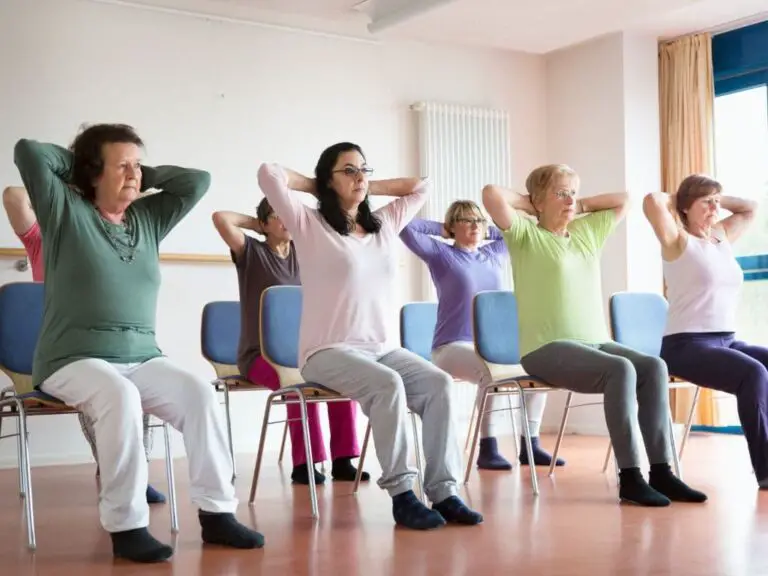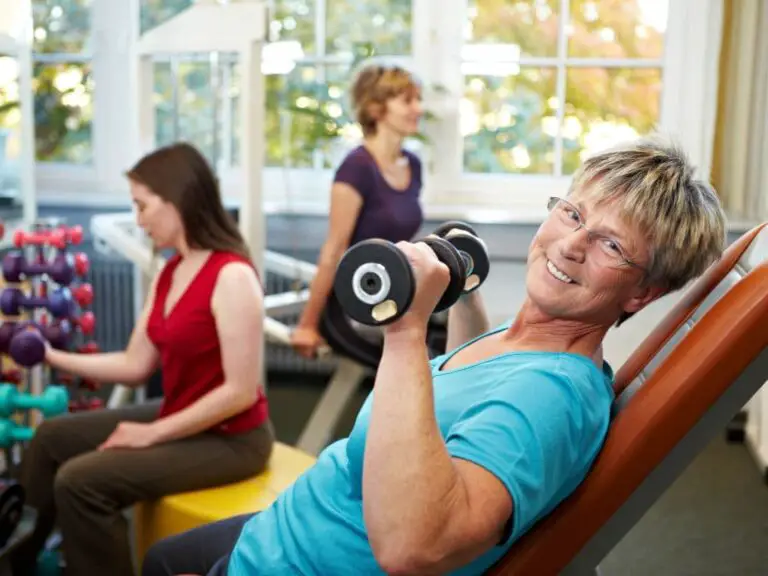Is a Stationary Bike Good for Hips?
Using a stationary bike can be an excellent low-impact cardio workout that provides many benefits for hip health. However, it’s important to use proper form and technique to prevent potential hip pain or injuries.
Is a stationary bike good for your hips? Yes, a stationary bike is beneficial for hips. It provides a low-impact cardio workout that strengthens hip muscles, improves mobility, and reduces pain. Proper seat height and posture are crucial to prevent strain. Recumbent bikes are especially good for those with hip pain due to their laid-back position which places less stress on the hips.
This article will explore how to optimize a stationary bike for hip alignment, the advantages of stationary biking for hip muscles and mobility, effective stationary bike exercises for hips, and tips to avoid hip discomfort.

Is Stationary Biking Good for People With Hip Pain?
For many people with hip pain caused by arthritis, injuries, or other conditions, stationary biking can be a great low-impact exercise option. The smooth, circular motion of pedaling a stationary bike provides gentle joint motion that can help lubricate the hip joint and strengthen the muscles that support and stabilize the hips.
Studies show that regular cycling on a stationary bike can help reduce hip pain and stiffness while improving overall hip function. The key is using proper seat height, posture, and settings to avoid placing excessive stress or strain on the hips during the workout. Starting slowly and gradually building up duration and resistance is also important.
Overall, stationary biking is often recommended by physical therapists and doctors as beneficial for people with mild to moderate hip pain. However, those with severe hip injuries, replacements, or advanced arthritis should consult their doctor first.
What Type of Stationary Bike Is Best for People With Hip Pain?
For individuals with hip pain or mobility issues, a recumbent bike is often the most comfortable stationary bike option. The laid-back reclining position places less stress on the hips compared to being hunched over the handlebars on an upright bike.
Recumbent bikes also allow you to sit back in the seat rather than bearing weight directly on the perineum, tailbone, and hips. This helps reduce discomfort in the joints. Many recumbent bikes also come with a wider, cushioned seat for additional comfort.
The semi-reclined position reduces strain on the lower back and hips, making it easier for people with hip pain to ride for longer durations. Handlebars on recumbent bikes are usually positioned at chest level rather than over the head, resulting in better posture.
How Can I Adjust the Seat and Handlebars on a Stationary Bike for Optimal Hip Alignment?
Properly adjusting your stationary bike settings is crucial for hip comfort and avoiding injury or strain:
- Set the seat height so your leg is almost fully extended at the bottom of the pedal stroke. Your knee should have a slight bend, not be locked.
- Make sure the seat is close enough to the pedals that your knees are directly above your feet as you pedal. Not too far forward or behind.
- Adjust the seat fore/aft so that your kneecap is vertically above the pedal spindle when it is at the 3 o’clock position.
- Tilt the seat very slightly downward to avoid excessive pressure on your hips.
- Position the handlebars at a height where you don’t have to hunch or reach. Keep good posture.
- Handlebars should be close enough to avoid overextending your hips or back.
Always make adjustments in small increments and pedal for a few minutes to check for comfort. Stand next to the bike periodically to verify seat height and position are correct.
What Are the Benefits of Using a Stationary Bike for Hips?
Regularly riding a stationary bike provides many excellent benefits for hip health:
1. Strengthening Hip Muscles
Cycling targets the key muscles that stabilize and support the hips, including the glutes, hamstrings, quadriceps, and hip flexors. Stronger hip muscles help improve mobility and prevent injuries.
2. Improving Hip Mobility
The smooth circular pedaling motion provides gentle mobilization of the hip joint capsule and lubricates the joint surfaces. This can help increase mobility and flexibility in the hips.
3. Reducing Hip Pain
Low-impact cycling boosts circulation to the hips while strengthening the surrounding muscles. This combination helps reduce hip pain related to arthritis, bursitis, injuries, and other causes.
4. Aiding in Hip Rehabilitation
After hip surgery, replacements, or injuries, cycling on a stationary bike is an excellent rehab exercise to improve mobility and regain strength. It allows gentle range of motion in a controlled manner.
5. Enhancing Hip Flexibility
Regular stationary biking stretches and loosens the muscles, tendons, and ligaments around the hips, improving overall flexibility. Good hip flexibility aids in mobility and preventing injuries.
What Exercises Can I Do on a Stationary Bike to Strengthen My Hips?
Beyond regular cycling, you can incorporate exercises into your stationary bike workout to further target and strengthen the hips:
- Bridge pedaling: Raise your hips off the seat to target the glutes. Pedal while in this bridge position.
- Wide stance: Widen your stance on the pedals to work the inner thigh and hip adductors.
- Single-leg pedaling: Pedal with one leg at a time to isolate each side. Switch legs and repeat.
- Resistance intervals: Increase the pedal tension for short intervals to strengthen the hips through a wider range of motion.
- Hills: Use hill mode to simulate climbing on the bike and tone the glutes.
- Backwards pedaling: Pedal gently in reverse to work the hip flexors and extensors through different angles.
How Can I Prevent Hip Pain While Using a Stationary Bike?
To avoid hip discomfort while using a stationary bike, keep these tips in mind:
- Maintain proper seat height, tilt, and distance from the handlebars. Improper bike fit strains the hips.
- Adjust the resistance to avoid pushing too hard. Start with lighter resistance and build gradually.
- Get up and stretch your hips every 10-15 minutes during longer rides.
- Lean slightly forward to take pressure off the seat and sit bones.
- Choose a comfortable gel seat or use a gel cover for more cushioning.
- Keep your hips and knees aligned with the direction of the pedals to avoid twisting.
- Build cycling duration gradually to condition your hip muscles. Don’t overdo it.
Can You Overdo Exercise on a Stationary Bike?
It’s certainly possible to overdo it on a stationary bike and cause hip pain or discomfort. Cycling for too long, using too much resistance, pedaling with poor form, or pushing through hip pain can lead to overuse injuries.
Signs you may be overdoing it include:
- Hip, groin, or buttock pain during or after riding
- Numbness or tingling in the legs
- Increased hip stiffness or soreness
- Extreme fatigue in the leg muscles
Make sure to build up gradually, take regular breaks, use proper form, and listen to your body. Ease up or stop if you feel any hip pain during your workout. It’s better to underdo it than overdo it when starting out.
What Are Some Effective Stationary Bike Workouts for Hips?
To maximize the hip benefits of stationary biking, aim for 30-45 minutes of cycling at least 3 days per week. Some great workout options include:
Beginner: Warm up for 5 minutes then do two 10-minute intervals of moderate cycling with 2 minutes of light cycling or stretching between. Cool down for 5 minutes.
Intermediate: Warm up then do 30 seconds hard resistance pedaling followed by 90 seconds light, for 10 intervals. End with a 5 minute cool down.
Advanced: 45 minutes alternating between steady moderate cycling, 30-second high resistance sprints, and hill climbs, ending with stretching.
Always start slow with light resistance, maintain proper form, and build up duration and intensity gradually over time. Listen to your body and avoid pushing through hip pain.
How Long Should You Ride a Stationary Bike for Hip Health?
Most experts recommend building up to 30-45 minutes per session on a stationary bike for optimal hip benefits. Longer duration rides of 45-60 minutes can be added once you have strengthened the hip muscles and conditioned your body.
Be sure to start slowly and gradually increase session length. Take regular breaks during longer rides to get up, stretch, and ensure proper bike fit. It’s better to aim for frequent, shorter rides of 30 minutes than occasional longer rides when starting out.
Consistently riding a stationary bike for at least 20-30 minutes three to five days per week will provide excellent low-impact strengthening and conditioning for the hips. But listen to your body and avoid overdoing it.
What Are Some Other Low-Impact Exercises That Are Good for People With Hip Pain?
Besides stationary biking, other gentle activities that can improve hip strength and flexibility include:
- Swimming: Excellent for full range of motion without impact or strain.
- Walking: Gentle rhythmical movement lubricates hip joint. Start slow.
- Water Aerobics: No impact, great hip toning, and gentle range of motion.
- Elliptical: Gliding motion works hips through controlled path.
- Yoga: Stretches hips and builds strength. Modify poses as needed.
- Pilates: Targets core, legs, and hips for balance and strength.
- Stretching: Simple daily stretching keeps hips flexible and mobile.
Any low-impact exercises that gently move the legs through full range of motion can benefit the hips. Just be sure to start slowly, use proper form, and stop if you feel pain. Consult a physical therapist to develop a safe, hip-friendly exercise program.
Conclusion
When used with proper seat height, posture, and form adjustments, stationary biking offers an excellent low-impact exercise for strengthening the muscles around the hips, lubricating the hip joints, enhancing flexibility, and reducing pain. Recumbent bikes provide an especially hip-friendly option. Interactive exercises that target the hips can be incorporated into the workout as well.
Just be sure to start slowly, focus on technique, and avoid overdoing it to prevent potential hip discomfort or injury. Consistent stationary bike workouts of around 30 minutes several days per week can provide great benefits for overall hip health.
Frequently Asked Questions
-
Does stationary bike help hips?
The benefits of stationary bike cycling are that it keeps your hips moving, which improves hip function and increases athletic performance. You can tone your abdominal and oblique muscles as well as the hips, back, legs and hips.
-
Why can’t I sit cross legged anymore?
If you are unable to cross your legs for long periods of time, it is an indication that you have tight muscles. Cross-legged sitting puts more strain on your inner thighs and ankles.
-
Where do you feel pain if your hip needs replacing?
Loss of cartilage can cause pain and inflammation. The hip arthritis pain is often felt in your groin, thigh or buttock. The pain may spread down to your knees from your thigh. It can make your hips more difficult to move.
-
Can sitting cause hip pain?
Poor posture can cause hip pain. However, if you sit for 40-50 hours per week, or more than 5 months, your hip strength will be diminished. You will feel less strong if you get up from the desk. Your core, hip extensors and glutes are weaker.
-
Why is pigeon pose so hard for me?
Why can’t you do Pigeon Pose? Pigeon Pose can be difficult because you lack the strength and flexibility that your glutes need. You can work your way up to Pigeon Pose by practicing variations like the Reclined Pigeon or Seated Pigeon Pose. To reduce tension, you can place a yoga block underneath your glutes.
-
How do you reverse arthritis in the hip?
Although there is no treatment for OA, it can be managed and slowed down. There are many lifestyle options available, including weight management, exercising, stress prevention, healthy eating habits, and avoiding unnecessary stress. There are many medical options available, including prescription and over-the-counter medications.
-
Does standing strengthen hips?
Standing hip abductor This is a great exercise to strengthen and stabilize the hip abductors while running or walking. This hip mobility exercise is great for seniors and strengthens your core muscles. It can also improve your walking ability. Hold onto the chair or wall while standing straight.
-
What exercises can I do to relieve hip pain?
External hip rotation (stretch). Press your knees towards the ground using your hands. Alternately, you can lie down on your stomach and separate your knees while keeping your feet together. Keep at it until you feel the stretch. Hold the position for about 10 seconds, then relax. You can do this 5-10 more times.
-
How do you lubricate your hip joint?
These can be found in salmon, tuna, oily fish, walnuts, olive oils, avocados, and omega-3 supplements that are high-in DHA. These joint preservation products are recommended. Combining glucosamine Sulfate with chondroitin supplements may be beneficial on two levels. They can increase lubrication, decrease inflammation, and thus reduce pain.
-
Can you reverse hip arthritis?
Although there is no treatment for OA, it can be managed and slowed down. There are many lifestyle options available, including weight management, exercising, stress prevention, healthy eating habits, and avoiding unnecessary stress. There are many medical options available, including prescription and over-the-counter medications.






